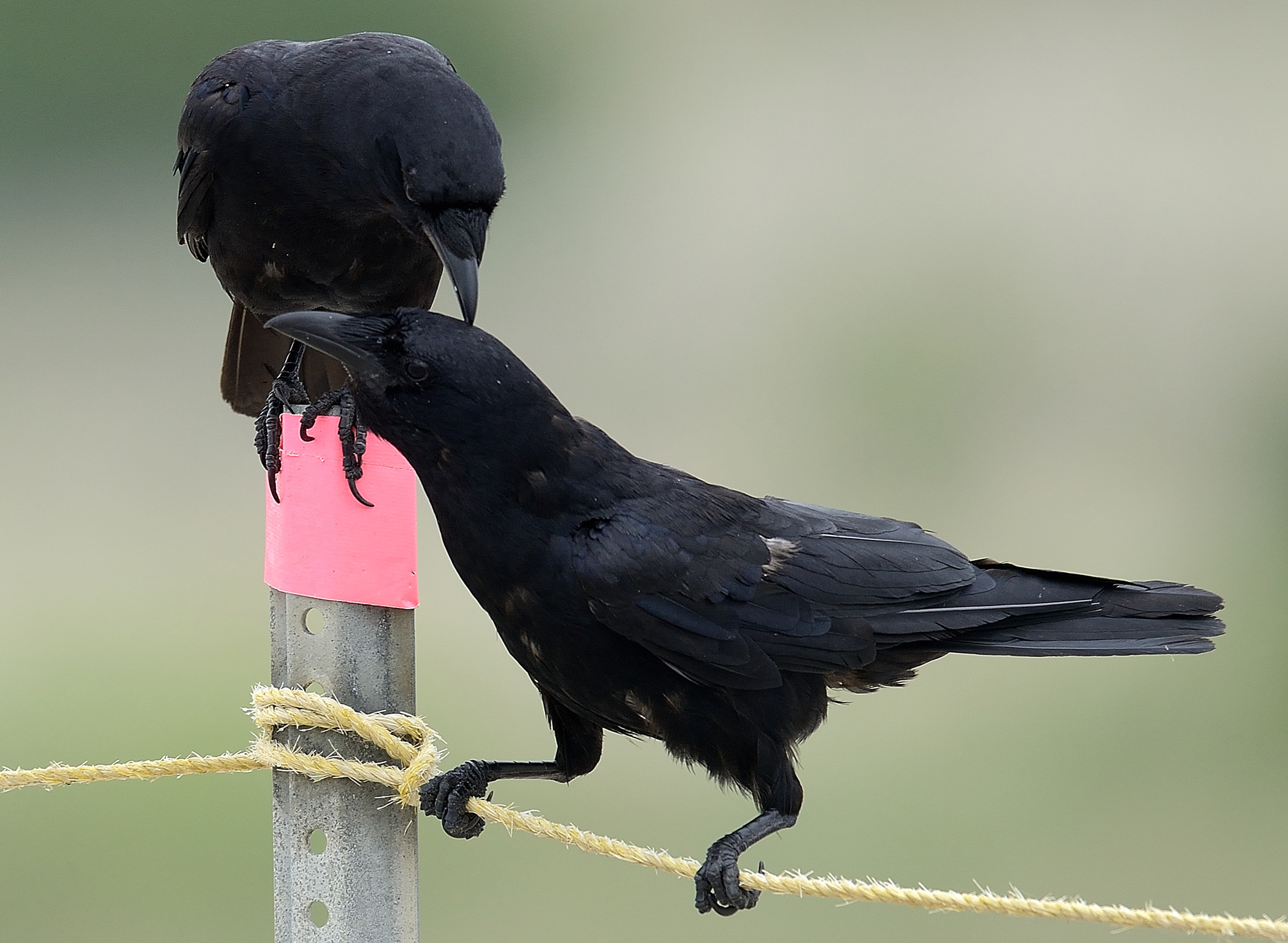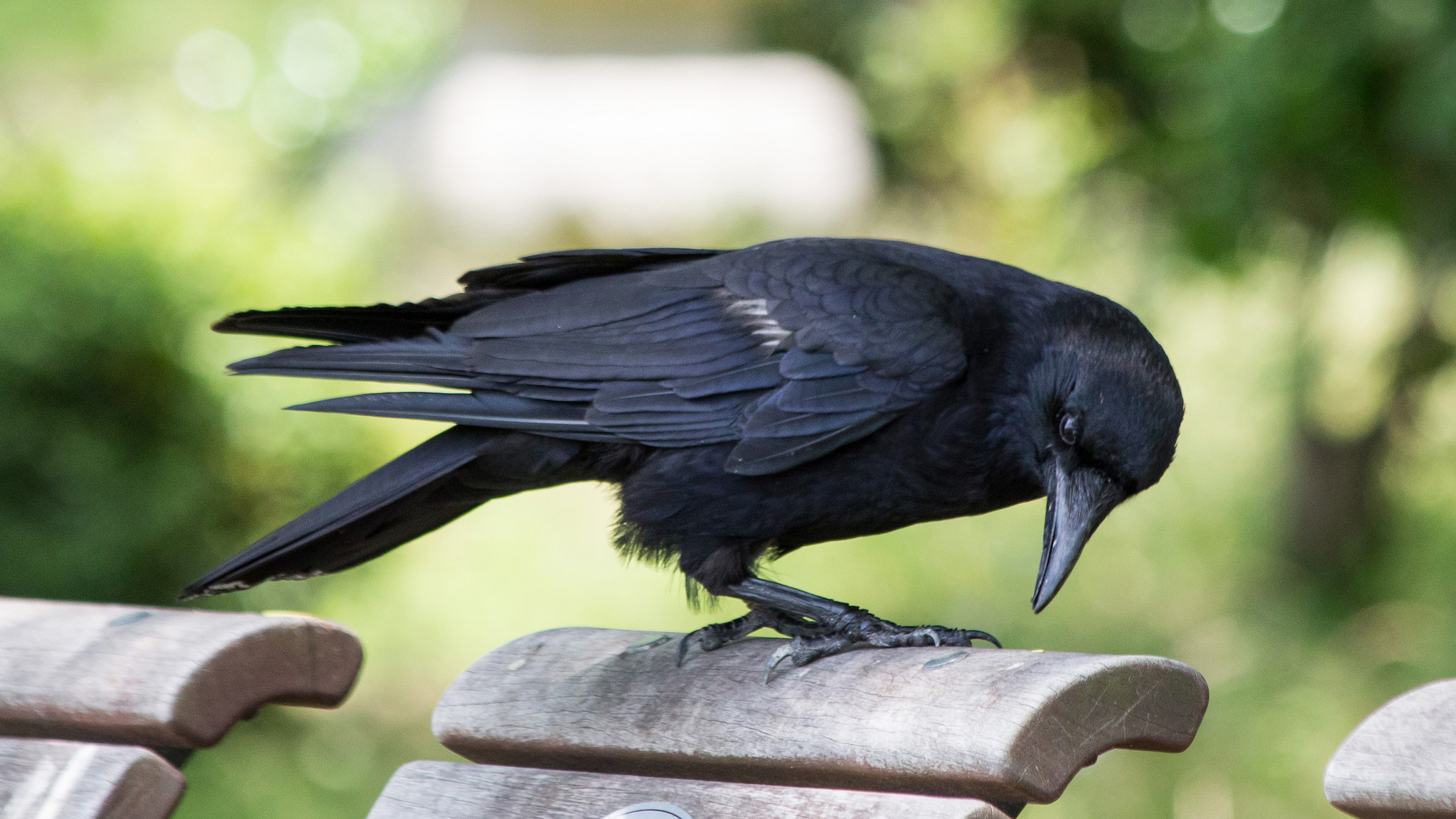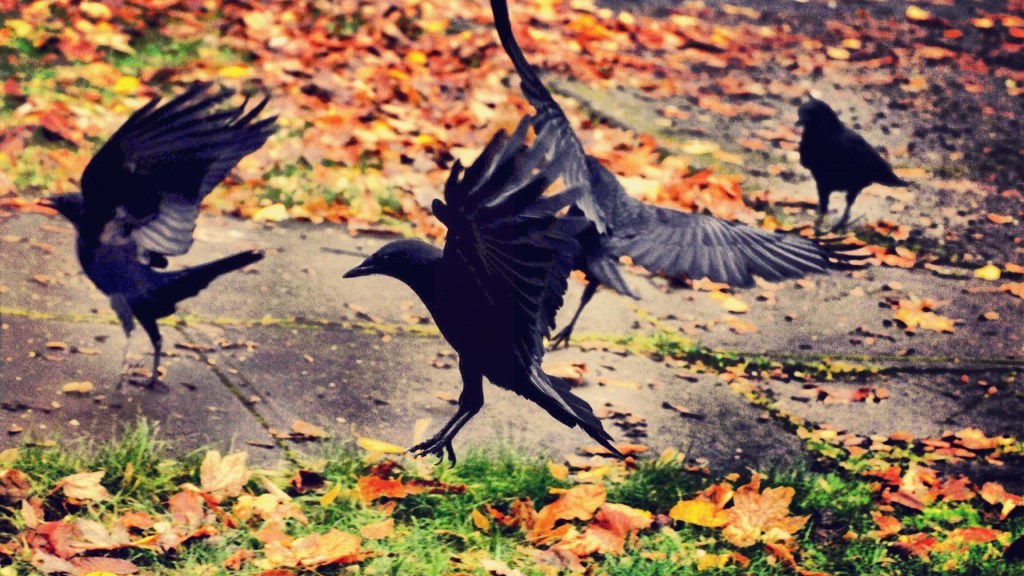No matter where you live, there’s a good chance there is a crow nearby. What you might not notice is the family drama going on all around you. Many crows, especially during nesting season, live in family groups.
Mated pairs share territories with their grown children. The older offspring in turn help their parents with raising each season’s new brood of young birds.
This type of family life may not happen among all crow species or in all places. For example, in North America, we know that American crows and Northwestern crows cooperatively breed, but there is no evidence yet that fish crows pursue this lifestyle.
Lawrence Kilham was among the first to describe cooperative nesting in American crows in the early 1980s. Kilham was an avocational ornithologist, starting his studies in middle age amidst a career as a virologist. His approach to studying bird behavior was intentionally simple – observe individual behavior as much as possible.
For his crow studies, he worked seven days a week from a lawn chair with a notebook and binoculars. He lucked into finding a tame population of crows in Florida that were regularly fed by the owner of a private ranch. He was able to sort out individual crows based on their behavior and plumage idiosyncrasies.
Using this approach, Kilham completed a series of studies on crows and ravens that are summarized in his book The American Crow and Common Raven. Ultimately Kilham published more than 90 scientific articles that yielded many new insights into bird behavior.

As observed by Kilham, the Florida ranch crows worked cooperatively on all parts of the nesting process.
Helpers would bring sticks and other nesting material to help the female build the nest. At one nest there were five helper crows busily bringing sticks “faster than the one female could handle them.” The project quickly became a disorganized mess.
Eventually, the female somehow communicated that it was time to halt stick deliveries. It took her an additional two weeks to finally complete the nest with the materials on hand.

Kilham concluded, “There is a limit, conceivably, to the number of adult auxiliaries that can be of help rather than a hindrance.” In other words, too many cooks in the kitchen … Yes, crows have this problem, too.
Throughout the incubation period, the female spends 90% of her time incubating. She is fed by her mate and the rest of the helpers a few times per hour.
Kilham noted that the visit rate of helpers at hatching time was very high, but they weren’t bringing any food. He noted that “it seems that many of the visits were made out of curiosity” and ”the female moved aside each time a helper came, giving it a chance to look at the young.”
From then on the real work began for the family, with parents and “helper crows” making more than 20 visits per hour to feed the nestlings. The young birds continued to be fed exclusively by older crows for at least two weeks after they left the nest.
Subsequent long-term crow studies in New York led by Kevin McGowan of Cornell showed that pairs, like those that Kilham had studied in Florida, had year-round territories with young that stayed with their parents for up to six years. No crow bred on its own until it was at least two years old. The biggest crow family they recorded was 15 birds.
Why do crows stay at home to help rather than go out on their own?
Our greatest insights into this question come from a research team working in Europe with carrion crows. They have executed a series of studies focused on determining where and when it is beneficial to be a helper.

The team noted that in Switzerland cooperative breeding was rare, while in Spain it was common. To learn whether nature (genetics) or nurture (the environment) was driving cooperative nesting and family living, they experimented by moving Swiss crow eggs into Spanish crow nests.
The results? Nurture all the way.
The Swiss crows raised by Spanish parents adopted the local lifestyle of family living, while their brothers and sisters back in Switzerland left the home territory shortly after reaching independence.
The researchers presented two possible explanations for the difference between the two study sites.
The first hypothesis was that in Spain, there might not be enough territories to go around (in other words, it’s a tough job market), so the grown kids live at home for a while longer until something opens up.
Although the “tough job market” explanation is tempting, it turns out that Spain actually has more vacant territories available than Switzerland does.
The second hypothesis was that there may be a difference in food availability between the two sites that influences a territory’s capacity to support a family.

This hypothesis was proven to be correct. A key behavioral difference between Switzerland and Spain is that Spanish crows stay on territories year-round, while in Switzerland (and in an Italian study site), crows abandon their territories after nesting season. This is probably because they need to go beyond the territory boundaries to meet their food needs during the colder parts of the year. Families are then prompted to split up and, by the next spring, last year’s offspring are no longer around to help.
Even in Spain, where year-round territoriality is common, food availability is an important factor in determining whether the young stay or go. Experiments that added extra food to some territories demonstrated that last year’s young are more likely to stick around if there is more food.
Sticking around does imply a tradeoff. Surely all young crows aspire to have a place of their own some day. But in the meantime, a good part of their genes are being passed on by helping to raise their younger brothers and sisters. We would expect that their experience as helpers might make these young crows more successful breeders once they do get out on their own.
Cooperative breeding is common enough for us to know that it is beneficial under certain situations. About 40% of the 116 species in the crow family (including jays, magpies and nutcrackers) are cooperative breeders. It’s estimated that across all bird species, only about 9% are cooperative breeders.
Whether you’re referring to a crow couple or a human couple, it’s safe to say, it takes a village.




We have crows in our back yard every year. This year we have a family of 7. I have noticed that one will stay mulling around the yard all day while the others are off doing whatever. I feel so bad for him. Why does he say behind?
Ellen
I am feeding a young crow I found somewhere…he was loudly begging for food….I took him home and he behaves like he knows me forever…he is soooo sweet! He loves to -talk- like a gremelin, jump on my back if I just bend to pick something…and he-s target is my head or my shoulder to sleep. Recently, there is a big one coming to my balcony, acting very aggressively. It keeps making loads of noise, it try to destroy my net like a peterossauros and my next door neighbour…it is scaring…Could be his mother despite the fact I found him far from here??
Hi Maria, Thank you for the question! It seems likely that you picked up a fledgling – birds of this age are often on the ground begging for food loudly. Their parents (and extended family) are still caring for them, but may be away finding food at the moment you happen upon the young bird. It’s an awkward, but normal stage of bird life. It’s hard to say for sure whether the crow on your balcony is a family member. Here is more information from Portland Audubon: https://audubonportland.org/wcc/urban/crows
Hello,
The pair of crows I have been feeding for about 2 years, had a chick last year. Their offspring is still with them every day. When I throw food out for them, if only one or 2 of them have seen it, they call to tell the other/s. They all seem very harmonious. They are still very cautious around me, even though I’m in a flat and am never near them on the grass. Often they can’t seem to get the courage to take the food, unless I’m out of sight, so the seagulls usually grab what I intended to give the crows. I love their calls and the way they walk!
Had a Fish crow as a pet onetime. It learned to say hello, Michael (one sons name) “hello Michael”and Oh wow. Used sticks as tools and his intelligence would amaze a person. If people were being recruited to be Crows few would pass the test. Two things to leave in the wild, a crow and a raccoon. Both be come a pain in the a-s after they get older. But the coon has a dangerous bite.
Hello,
I have observed crows in my backyard in Ft. Greene, Brooklyn, NY (not recently).
I observed parent crows bringing their juvenile crows and placing them on two dead stumps of trees (maybe 12 feet up or so). The parents then demonstrated, in another tree, how to get away from an upside down (eating) position. The youngsters observed, and the parents demonstrated over and over again, three times at least.
On another occasion, these crows were observed teaching their young how to mob a squirrel. She had a young one she was teaching how to navigate the wires that run along the backyards. The crows attacked her (a feignt) and she defended herself and her baby. It wasn’t a serious attack, just a demonstration of how it could be done.
Crows are the best!
I have a pet crow that I’ve had for about 5 years. I rescued him when he was very young and on the ground with no way to get back up to the nest. After a few months I took him back to the same place and tried to release him. I held him on my arm, with the other crows screeching at us, but he wouldn’t leave. When a stranger walked up behind me, it scared him and he flew into the top of a nearby tree. This was in a busy, noisy area on a Thursday. He stayed in the tree for two days without moving. I returned early on Saturday morning, when the weekday noise and traffic wasn’t a factor. As soon as I got out of my car, and he saw me, he flew toward me, and landed in a tree near me. He then flew over my head to another, closer tree. I turned to him and put my arm out. He immediately flew down and landed on my arm. I took him back home, and he’s been my “Buddy” (that’s his name) ever since. He is THE BEST pet ever. Amazing intelligence and personality. So much fun to have around. I wouldn’t trade him for ANYTHING.
Used to have a whole family of crows that came, year around (MN) now only two!? The Peregrines and Eagles are doing them in! They came for peanuts! They groomed each other! Safety in numbers I assume…. Don’t know if anymore will be back? Too many vulture birds….. They’re neat to watch!!! They seem to be all connected!? And shared the peanuts with each other…….
Years ago (I was a kid) was riding my bike and a crow landed on my head! I didn’t hurt him, just tried to keep the nails out of my eyes. eventually he hopped on my arm, turned around, and we stared at each other!? And he could talk!!! Said ‘by’, ‘hi’, and others I couldn’t understand.. quite an experience! Somebody must’ve taken care of him as a baby…….?
I have great respect for crows abilities, in general. I’ve seen a large murder of crows in the snow at 8,000+ feet on Blue Ridge in the eastern most of the San Gabriel mountains, where no other life was apparent in the middle of winter, except us mountain bikers, my wife and me.
Another time, while mtn biking on a paved trail alongside the concrete hillside channel in Rancho Cucamonga, we saw crows flying down-channel with walnuts in their beaks. We followed them up to several walnut trees on Beryl Street, just above Hillside, where they were gathering the walnuts. We saw them drop the nuts for height onto the hard surfaces in Heritage Park, near to where they were gathered, to crack the hard shells and expose the edible nutmeat. No dumb birds these, and tough too.
It is wonderful what we can learn from animal, if we would take the time to open our eyes
Thank you for a delightful and informative article.
My wife and I are ardent bird watchers. Crows and other corvids are among our favorites because of their complex social life, intelligence, and probably complex language. For example, as our kumquats become ripe, a few crows check the tree out each day. When the fruit is finally ripe, the entire family joins in on the feast. One bird must have a way of telling the others, “Goodies to eat…follow me.”
What do they chatter about at the evening roost? They sound suspiciously like a bunch of people getting together and sharing the latest news and gossip.
Another delightful thing about crows is their playfulness. Besides teasing each other, they play flying games, especially when flying toward the roost. It’s worth watching them do barrel roles, occasional loops, or purposefully fly into each other or sneak up behind another, all the while flying rapidly and noisily chatting with each other.
Looking at crows with affectionate eyes, we find them beautiful with their elegant ebony coloration, tight muscular bodies, bright alert eyes, and sleek aerodynamic shape.
I loved this article and thank you for more info on amazing crows! Our “bird man” in Minnesota, Stan Tekiela gave the first amazing talk on crows in our area and I’ve followed them with amazement day by day. Thank you, Joe. Lydia Holsten
I am so impressed how this article was written! As an aspiring science communicator, I am inspired how well of a job Dr. Smith did of making the article readable, relatable, and strewn with awesome analogies. However, I’m on the fence about the line, “This hypothesis was proven to be correct.” Because obviously you can never prove, only support. I’m on the fence because I’m torn with what is ‘correct’ so we are not giving the public inaccurate information, but also compromise of technical wordage and concepts for communication is to be often necessary. Dr. Smith, could you elaborate on the motive behind this statement so I could adopt it into my scientific communication skillset?
Crows! Fascinating.
We had a wet,heavy snow storm late April, our neighbors pine snapped off (15 ft ) at top where a crows nest was. ..landed in our back yard. I noticed a big black crow flayling in the heavy snow on ground. …we’ve got a dog, couldn’t let her out. ..I felt so bad for the bird. …with towels I gently, loosely captured him, and recovered nest.he/she had injured shoulder /elbow (I dunno, not knowledgeable bird wise )some blood, and unable to fly…..mate hovering, very concerned. Crow spent night in basement laundry sink,in nest,with H2o,and,safely contained. Next day,so happy, still alive, looking bett.
A BIG shout out and grateful thank you to Birds of Prey foundation in Broomfield, CO.,1 of 2 rescue and rehabilitation programs in our state.
The crow(3 weeks now )was in their ICU ,and is recovering steadily, and about to go into next stage, in outside enclosure to strengthen his wings. Next step, released within 10 mile radius of capture. Makes me smile. His mate still hanging near looking for partner. …
Magnificent smart beautiful creatures!
Crows are without a doubt the smartest birds ever